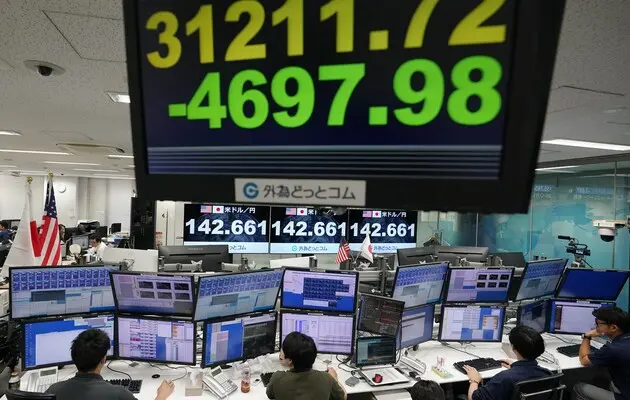Collapse in the World Stock Markets. What Does it Portend for the World Economy and Ukraine?
In July, the "Texas Chainsaw Massacre" on global financial markets took on a threatening character. The apocalypse of 2008 is still a long way off, but in one month, the world's stock markets lost almost $5 trillion (up to $2 trillion on Black Monday, August 5 alone).
At the same time, the main fall occurs in the segment of the so-called big tech, namely the seven largest technology companies of the United States of America. But the collapse of the markets spread very quickly to other countries as well — the stock markets fell in Europe, in particular in Germany, but a particularly strong collapse occurred in Japan. Shares in South Korea and Taiwan also fell significantly in price.
Japanese stock markets overall suffered their deepest drop since Black Monday in 1987. Japan now has two Black Mondays in its history of financial markets.
The collapse itself began on Friday, August 2, when shares of American big tech were actively sold off on the Nasdaq exchange.
The day before, rather pessimistic statistics of the labor market in the United States of America were released: the seasonal increase in vacancies in July amounted to 114,000, although analysts predicted up to 200,000. In addition, the unemployment rate in the United States of America rose rather sharply to 4.3% (a three-year maximum). Rising unemployment is one of the most characteristic signs of a cooling economy and a signal of increased risk of a future recession.
An unwritten rule has recently appeared in economics: if the adjusted unemployment rate for a three-month period is 50 basis points higher than the corresponding minimum rate for the past year, this indicates a high risk of recession. This is what we have now.
At the close of trading, the Nasdaq Composite fell by more than 10% these days. Big tech giants Amazon fell by 8.79% and Intel fell by 26.06%. In addition, shares of Nvidia fell (by 10%), trillion-dollar companies Apple, Amazon, Microsoft, Alphabet, Google, Tesla.
But the greatest rates of decline were recorded in Japan — on the Tokyo Stock Exchange (Nikkei index) by 12.4%. In the subsequent quotations, they almost regained their lost positions, but at the end of trading on Tuesday, the fall resumed. In the coming days, high volatility in the Asian markets will continue, so we can expect both a drop and a temporary correction to recover.
In Taiwan, shares of local tech giant TSMC fell immediately by 8.4%.
South Korea's stock market fell by nearly 9% (the worst performance since the 2008 global crisis).
Experts immediately drew attention to the fact that the greatest volatility of share prices occurred in the five American big tech companies: Alphabet, Amazon, Apple, Meta and Microsoft, which were actively developing new products based on artificial intelligence (AI).
This prompts the search for fundamental causes of the collapse.
It is well known that the world economy develops according to cycles of business activity: long, medium, short.
The basic economic cycle is the long Kondratiev cycle, named after the famous economist of the 20th century, who was destroyed in the storm of Stalinist repressions.
Understanding the cyclical nature of the world economy provides the most accurate answers to the causes and course of world crises, in particular in the financial markets.
We can say that crises are a mirror of economic cycles.
The long Kondratiev cycle of 40-50 years began in the early 80s of the last century and, according to theory, should have lasted until the early 20s of the current century.
The Kondratiev cycle is divided into two K-half-cycles approximately 20 years long. Accordingly, in the first K-semi-cycle, the economy grows, in the second K-semi-cycle, it is in a trend of lower development rates (this half-cycle may periodically be interrupted by a fall).
Accordingly, the second half-cycle of the great downward Kondratiev cycle began after the global crisis of 2008 and was supposed to last until the mid-20s.
If we carefully analyze, we can see that Gross domestic product (GDP) of a significant number of countries in the world (with the exception of certain economies) grew at a significantly lower rate after 2008 than at the beginning of the early 2000s. That is, the rule of "internal cyclicality" works within the framework of long cycles.
Usually, a long cycle is based on a suitable technological structure that forms a suitable mass market, i.e. products of mass consumption, which become a driver of the development and process of consumption and growth of the economy as a whole and of individual leading companies, in particular.
Moreover, a new technological order, as a rule, is born in the depth of the previous economic cycle, because it takes a certain amount of time to scale up inventions and launch them in series.
In particular, the fifth technological order (scientific and technical revolution, the era of computers and telecommunications) was born in the 70s of the last century. In addition (the emergence of Silicon Valley in California), although the modern long cycle of economic development itself, as we have already mentioned, began after the recession in the United States of America in the early 80s of the last century (the famous period of "Reaganomics").
Thus, the era of steel and oil ended, and the era of telecommunications and electronics began. Although, of course, any long economic cycle contains not only the mass market of the basic technological structure (today it is the fifth). The economic cycle includes elements of all previous technological systems, because the production of metal, oil products, coal, and textiles continues.
At the finish line of a long economic cycle, it already contains elements of the next technological order. Now this is the predicted sixth technological order: nano-, bio-, information and cognitive technologies, or NBIK-convergence.
As historical experience shows, the link or loop between cycles almost always occurs in the form of a crisis, mostly in financial markets. It is explained very simply: the old mass market dies faster than a new one appears. It is not about the reduction of production in pieces or tons, but about the ability of the mass market to act as a powerful driver of development and a magnet for investments on the stock market: the project to produce the 100th iPhone model will not cause the same revival in the market as products with artificial intelligence.
However, the appearance of a new mass market is the conditional birth of a new long economic cycle of Kondratiev. Sometimes this birth is quick and painless (as it was during the fifth technological order), and sometimes it is long and extremely difficult (as it is now).
Everyone is waiting for the emergence of a new mass market of the sixth technological order: products with AI, glasses with a 3D range of vision (Nvidia product), technologies for integrating individual consciousness into cloud services, etc.
However, it is currently not possible to buy these glasses in every supermarket, and there are no queues to implant chips into the brain yet. And therefore, the mass market of the sixth technological order and the new economic growth cycle announced by American big tech, which was supposed to start in the second half of the 20s, turned out to be a false start or a false branch of technological evolution in the context of the product mass market, and not exclusively in theoretical scientific application.
The first to understand this was Warren Buffett, who began to quickly transfer his investments from big tech stocks to ordinary dollar cash at the peak of stock quotes.
But there are not only long cycles, but also short and medium-term ones.
Mid-term are the Juglar's cycles lasting up to ten years. Since 2023, we have entered the declining phase of this cycle, which characterizes the level of production loading and the level of inventory (risks of overproduction — this is now observed, for example, in the segment of electric cars).
The short Kitchin cycle characterizes the level of aggregate demand, its length up to five years (it is now also on a declining segment).
It can be said that the Kitchin cycle is catching up with the Juglar cycle. That is, it is meant that first the aggregate demand for goods falls and only then, with a certain time delay, production decreases and the volume of goods in warehouses in stocks increases. This happens due to a certain inertia of the business: if the production is loaded, the business does not immediately notice the gradual reduction in demand for its products.
A similar situation existed in 2018, when the declining stage of the three cycles was concentrated in one point, but this dynamic was interrupted for several years by the coronavirus pandemic (2020–2021) and the post-pandemic “rebound” of the world economy (2022–2023). But now the "parade of cycles" is happening again.
This carries the threat of recession for the world's key economies (at a minimum, their slowdown to the level of Gross domestic product (GDP) growth by 1–2% per year, at the maximum there is a threat of a drop of 0.5–1.5%).
And this cooling of the economy will take place until the world economy launches a new mass market of the sixth technological order. And this order, in turn, will launch a new long Kondratiev cycle and its half-cycle of growth for the next 20 years.
This also explains the fierce geopolitical struggle between China and the United States of America: it is about who will become the leader of this period of growth and form global technological chains of added value.
What does this portend for Ukraine?
On the one hand, our economy is now somewhat isolated by the war from world processes. If there had been no war, non-residents would have already started to leave the domestic government bonds market and withdraw capital, the hryvnia would devalue, and the National Bank of Ukraine (NBU) would increase the discount rate. This is currently not the case, because non-residents left the domestic government bonds market on the eve of the war, and the outflow of capital from Ukraine is blocked.
However, there will be indirect effects. The United States of America will soon be dealing with a whole set of internal problems related to financial imbalances and deficits. The situation will be difficult in the economies of the European Union, Great Britain and Japan.
The struggle between China and the United States of America for technological leadership in the new 20-year growth cycle will intensify.
Therefore, this may affect the volume of financial assistance to Ukraine already in the fall. Also, a kind of "de-escalation rhetoric" may prevail in the world, which will affect the amount of not only financial aid, but also military aid.
Therefore, it cannot be ruled out that in 2025 Ukraine will have to rely much more on internal forces and resources.
Read this article in Ukrainian and russian.
Please select it with the mouse and press Ctrl+Enter or Submit a bug












 Login with Google
Login with Google